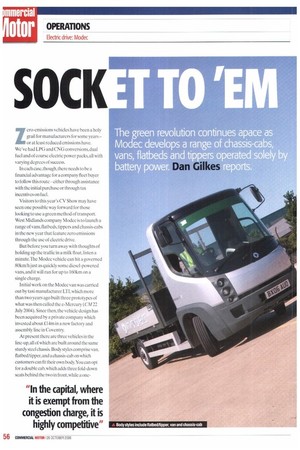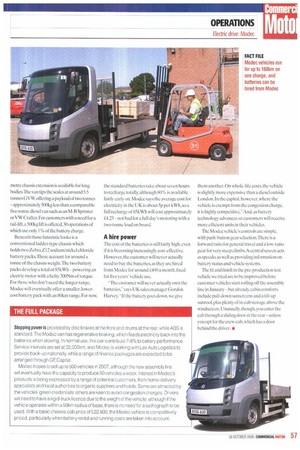SOCK
Page 56

Page 57

If you've noticed an error in this article please click here to report it so we can fix it.
The green revolution continues apace as Modec develops a range of chassis-cabs, vans, flatbeds and tip s operated solely by battery power 'YT
OPERATIONS Electric drive: Modec Zero-emissions vehicles have been a holy grail for manufacturers for some years — or at least reduced emissions have. We've had LPG and CNG conversions, dual fuel and of course electric power packs, all with varying degrees of success.
In each case, though, there needs to be a financial advantage for a company fleet buyer to follow this route— either through assistance with the initial purchase or through tax incentives on fuel.
Visitors to this year's CV Show may have seen one possible way forward for those looking to use a green method of transport. West Midlands company Modec is to launch a range of vans, flatbeds, tippers and chassis-cabs in the new year that feature zero emissions through the use of electric drive.
But before you turn away with thoughts of holding up the traffic in a milk float, listen a minute.The Modec vehicle can hit a governed 80km/h just as quickly some diesel-powered vans, and it will run for up to 160km on a single charge.
Initial work on the Modec van was carried out by taxi manufacturer LTI, which more than two years ago built three prototypes of what was then called the e-Mercury (CM 22 July 2004). Since then, the vehicle design has been acquired by a private company which invested about £14m in a new factory and assembly line in Coventry.
At present there are three vehicles in the line-up, all of which are built around the same sturdy steel chassis. Body styles comprise van, flatbed/tipper, and a chassis-cab on which customers can fit their own body. You can opt for a double cab, which adds three fold-down seats behind the two in front, while a one metre chassis extension is available for long bodies.The van tips the scales at around 5.5 tonnes G-VW, offering a payload of two tonnes approximately 500kg less than a comparable five-tonne diesel van such as an M-B Sprinter orVVV Crafter. For customers with a need for a tail-lift, a 500kg lift is offered, 30 operations of which use only 1% of the battery charge.
Beneath those futuristic looks is a conventional ladder-type chassis which holds two Zebra Z12 sodium/nickel chloride battery packs.These account for around a tonne of the chassis weight.The two battery packs develop a total of 85 kWh powering an electric motor with a hefty 300Nm of torque. For those who don't need the longer range. Modec will eventually offer. a smaller. lowercost battery pack with an 80km range. For now, the standard batteries take about seven hours to recharge totally, although 80% is available fairly early on. Modec says the average cost for electricity in the UK is about 5p per kWh, so a full recharge of 85kWh will cost approximately £4.25not bad for a full day's motoring with a two-tonne load on board.
A hire power
The cost of the batteries is still fairly high, even if it is becoming increasingly cost-effective. However, the customer will never actually need to buy the batteries, as they arc hired from Modec for around i400 a month, fixed for live years' vehicle use.
-The customer will never actually own the batteries," says UK sales manager Gordon Harvey. "If the battery goes down. we give them another. On whole-life costs, the vehicle is slightly more expensive than a diesel outside London. In the capital, however, where the vehicle is exempt from the congestion charge, it is highly competitive.-And, as battery technology advances, so customers will receive more efficient units in their vehicles.
The Modec vehicle's controls are simple, with push-button gear selection.There is a forward ratio for general travel and a low-ratio gear for very steep climbs.A central screen acts as speedo, as well as providing information on battery status and vehicle systems The fit and finish in the pre-production test vehicle we tried are to be improved before customer vehicles start rolling off the assembly line in January-but already, cabin comforts include pull-down sunscreens and a tilt-up sunroof, plus plenty of in-cab storage above the windscreen. Unusually, though, you enter the cab through a sliding door at the rear -unless you opt for the crew-cab, which has a door behind the driver, •
THE FULL PACKAGE Stopping power is provided by disc brakes at the front and drums at the rear, while ABS is standard, The Modec van has regenerative braking, which feeds electricity back into the batteries when slowing. In normal use, this can contribute 7-8% to battery performance. Service Intervals are set at 32,000km, and Modec is working with Lex Auto Logistics to provide back-up nationally, while a range of finance packages are expected to be arranged through GE Capital.
Modec hopes to sell up to 500 vehicles in 2007, although the new assembly Ire will eventually have the capacity to produce 50 vehicles a week. Interest in Modec's products is being expressed by a range of potential customers, from home-delivery specialists and local author-ties to organic suppliers and hotels. Some are attracted by the vehicles' green credentials, others are keen to avoid congestion charges. Drivers will need to have a rigid-truck licence due to the weight of the vehicle, although if the vehicle operates within a 50km radius of base, there is no need for a tachograph to be used. With a basic chassis-cab once of £22,800, the Modec vehicle is competitively priced, particularly when battery rental and running costs are taken into account.
























































































































































































